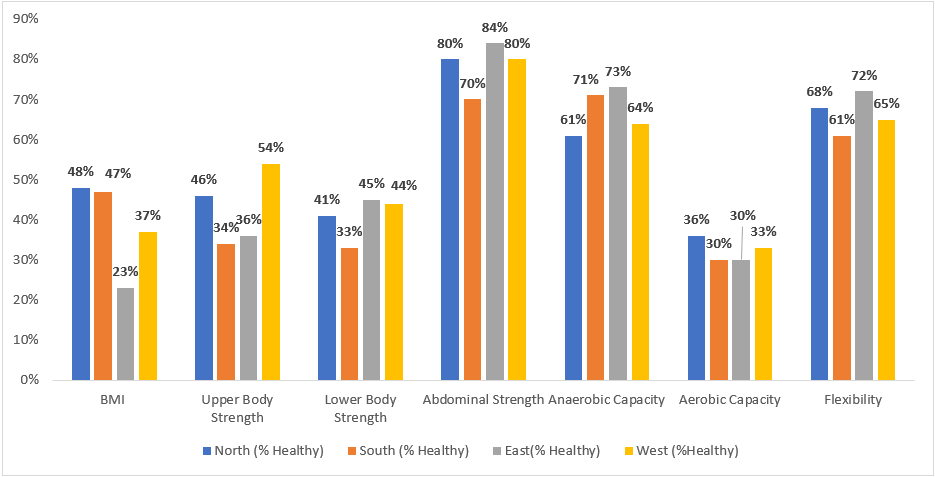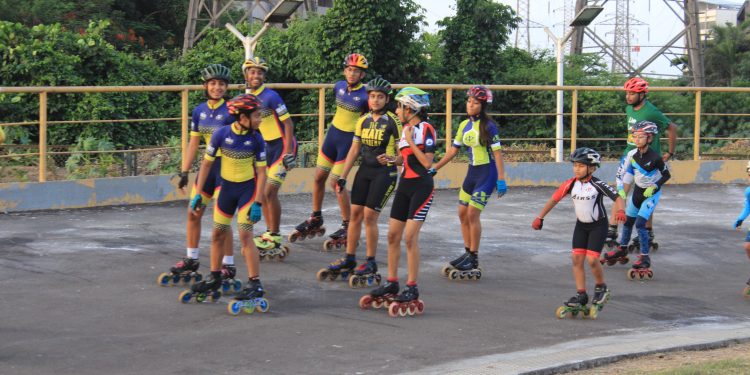The 11th Annual Health Survey conducted on 2-5 lakh children across India highlights the impact that school shutdowns have had on children’s health
While the immediate and obvious conclusion of the school closures that affected more than 320 million children in India would be that this has severely affected the academic rhythm and performance, yet the latest Sportz Village’s Annual Health Survey (AHS) reveals that this has also affected the ability of children to stay active and healthy. The survey which covered more than 2.5 Lakh children across 250 towns
The percentage of children having healthy levels of Aerobic Capacity and Core Strength during this period dropped drastically by 33% and 10% respectively.
The report looked at the state of health of children on the following fitness parameters – Body Mass Index (BMI), Aerobic Capacity, Anaerobic Capacity, Abdominal or Core Strength, Flexibility, Upper Body Strength and Lower Body Strength. And the results are worrying.
- 1 in 2 children do not have healthy BMI.
- 1 in 2 children do not have the adequate Upper Body Strength.
- 2 in 3 children do not have the adequate Lower Body Strength.
- 1 in 6 children do not have the desired Abdominal Strength.
- 1 in 3 children do not possess the desired Flexibility.
- 2 in 3 children do not have the desired Aerobic Capacity.
- 1 in 3 children do not possess the desired Anaerobic Capacity.
The survey also brought to light the differing health performance of children based on their gender, the region they are from and the schools they attend (public or private).
Fitness Analysis: Girls versus Boys
According to the survey, the percentage of girls with healthier BMI levels (48% of girls have healthy BMI scores) is more when compared to only 44% of boys. The girls also fared better in Flexibility and Upper Body Strength. However, they did not fare well in Aerobic Capacity and Lower Body Strength.
Fitness Analysis: Regional
Children from the North are healthier than children from the rest of the country with best numbers in the parameters of BMI and Aerobic Capacity, and above-average numbers in the parameters of Flexibility, Upper Body Strength, Lower Body Strength and Core Strength. However, they performed extremely poorly in Anaerobic Capacity.
The overall performance of the children from the South is concerning. Although in some parameters they showed average or above-average performance, they performed poorly in Upper Body Strength, Lower Body Strength and Core Strength.
Children from the East have performed exceptionally well with the best numbers in Lower Body Strength, Core Strength, Anaerobic Capacity and Flexibility. However, they performed poorly in BMI.
Children from the West had an overall average performance with above-average numbers in most health parameters. They however, had the best numbers in Upper Body Strength.
Fitness Analysis: Public Schools versus Private Schools
The survey further reveals, more children in private schools have healthy BMI levels (46%), compared to the children from government schools (42%). Children from private schools also fared better in Upper Body Strength and Core Strength, whereas they did poorly in Flexibility.

While this is concerning, there is a clear way forward to address this issue – and that is to get children active. With the rollout of the vaccines, schools will be gradually opening over the coming months. There is a need to ensure that the play time that children get in the schools is structured so that they can extract the most value out of it. Saumil Majmudar, Co-Founder and Group CEO, Sportz Village, says, “ Although this is a cause for concern, we know how to combat the issue. Structured play that is inclusive and age-appropriate, directly impacts several health parameters such as Upper Body Strength, Lower Body Strength, Aerobic and Anaerobic Capacity. School leaders can help address the key challenge through inclusion of adequate structured sports or physical education periods, both online and offline, in the academic curriculum for the coming academic year. Parents can also help improve their child’s fitness by encouraging good screen time that gets children active at home in case there are restrictions around play in the neighborhood.”
Description of the parameters:
Body Mass Index (BMI): A value derived from the weight and height of an individual and is used to gauge whether a person is within a healthy weight range.
Aerobic capacity: The ability of the heart and lungs to get oxygen to the muscles.
Anaerobic capacity: The total amount of energy from the anaerobic (without oxygen) energy systems. It is useful during high intensity short duration exercises or tasks such as sprinting.
Abdominal or Core strength: The strength of the muscles of the torso which helps to determine posture.
Flexibility: The ability of one’s joints to move freely.
Upper body strength: The strength of muscles such as Pectorals (chest), Rhomboids (upper back), Deltoids (outer shoulder), Triceps (back of upper arm) and Biceps (front of upper arm).
Lower body strength: The strength of muscles in the legs such as quadriceps (the muscles on the front of the upper leg), Hamstrings (the muscles on the back of the upper leg), Gluteals, Hip Flexors, and Calf muscles.













